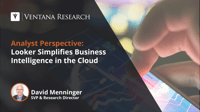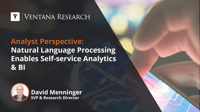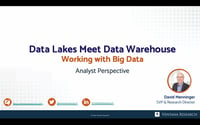I recently wrote about the need for organizations to take a holistic approach to the management and governance of data in motion alongside data at rest. As adoption of streaming data and event processing increases, it is no longer sufficient for streaming data projects to exist in isolation. Data needs to be managed and governed regardless of whether it is processed in batch or as a stream of events. This requirement has resulted in established data management vendors increasing their focus on...
Read More
Topics:
Big Data,
Cloud Computing,
Data Governance,
Streaming Analytics,
Streaming Data & Events
I recently noted that as demand for real-time interactive applications becomes more pervasive, the use of streaming data is becoming more mainstream. Streaming data and event processing has been part of the data landscape for many decades, but for much of that time, data streaming was a niche activity. Although adopted in industry segments with high-performance, real-time data processing and analytics requirements such as financial services and telecommunications, data streaming was far less...
Read More
Topics:
Big Data,
Data,
Streaming Analytics,
Analytics & Data,
Streaming Data & Events
I have recently written about the importance of healthy data pipelines to ensure data is integrated and processed in the sequence required to generate business intelligence, and the need for data pipelines to be agile in the context of real-time data processing requirements. Data engineers, who are responsible for monitoring, managing and maintaining data pipelines, are under increasing pressure to deliver high-performance and flexible data integration and processing pipelines that are capable...
Read More
Topics:
Big Data,
Cloud Computing,
Data Management,
Data,
data operations
We’ve recently published our latest Benchmark Research on Data Governance and it’s fair to say, “you’ve come a long way, baby.” Many of you reading this weren’t around when that phrase was introduced in 1968 to promote Virginia Slims cigarettes, but you may have heard the phrase because it went on to become a part of popular culture. We’ve learned a lot about cigarettes since then, and we’ve learned a lot about data governance, too.
Read More
Topics:
Big Data,
Data Governance,
Data Management,
Analytics & Data
Organizations face various challenges with analytics and business intelligence processes, including data curation and modeling across disparate sources and data warehouses, maintaining data quality and ensuring security and governance. Traditional processes are slow when transforming large and diverse datasets into something which is easily consumable in BI. And, it can take days or weeks to create reports and dashboards — maybe longer if processes change and new data sources are introduced....
Read More
Topics:
Big Data,
Analytics,
Business Intelligence,
Cloud
Natural language processing (NLP) is a field that combines artificial intelligence (AI), data science and linguistics that enables computers to understand, interpret and manipulate text or spoken words. NLP includes generating narratives based on a set of data values, using text or speech as inputs to access information, and analysing text or speech, for instance, to determine its sentiment. There are various techniques for interpreting human language, ranging from statistical and machine...
Read More
Topics:
Big Data,
Analytics,
natural language processing,
NLP
Having just completed the 2021 Ventana Research Value Index for Analytics and Data, I want to share some of my observations about how the market has advanced since our assessment two years ago. The analytics software market is quite mature and products from any of the vendors we assess can be used to effectively deliver information to help your organization improve its operations. However, it’s also interesting to see how much the market continues to advance and how much investment vendors...
Read More
Topics:
Big Data,
Key Performance Indictors,
embedded analytics,
exadata,
Analytics,
Business Collaboration,
Business Intelligence,
Collaboration,
Data Preparation,
Digital Technology,
natural language processing,
Conversational Computing,
collaborative computing,
mobile computing,
AI & Machine Learning
I am happy to share insights gleaned from our latest Value Index research, an assessment of how well vendors’ offerings meet buyers’ requirements. The Ventana Research Value Index: Analytics and Data 2021 is the distillation of a year of market and product research by Ventana Research. Drawing on our Benchmark Research, we apply a structured methodology built on evaluation categories that reflect the real-world criteria incorporated in a request for proposal to analytics and data vendors...
Read More
Topics:
Big Data,
Analytics
I’m proud to share Ventana Research’s 2021 market agenda for digital technology. Our focus in this agenda is to deliver expertise to help organizations prioritize technology investments that increase workforce effectiveness and organizational agility, ensuring ongoing operation during any type of disruption.
Read More
Topics:
Big Data,
Analytics,
Cloud Computing,
Internet of Things,
Digital Technology,
Robotic Process Automation,
blockchain,
Conversational Computing,
mobile computing,
extended reality,
AI & Machine Learning
In this analyst perspective, Dave Menninger takes a look at data lakes. He explains the term “data lake,” describes common use cases and shares his views on some of the latest market trends. He explores the relationship between data warehouses and data lakes and share some of Ventana Research’s findings on the subject. He also provides an assessment of the risks organizations face in working with data lakes and offers recommendations for maximizing the potential of data.
Read More
Topics:
Big Data,
Data Warehousing,
Analytics,
Business Analytics,
Business Intelligence,
Data Governance,
Data Management,
Data Preparation,
data lakes



















